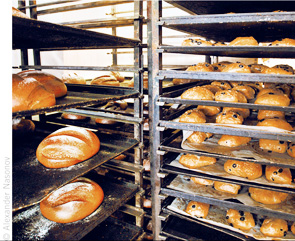 Independent commercial kitchens and culinary incubators are supporting the growth of the food and beverage industry in the U.S. While the exact number of food incubators is unknown, data from the Specialty Food Association indicates there are 150 shared kitchen spaces in the U.S., up 40 percent from about five years ago. In addition to serving as a cost-effective point of entry for entrepreneurs, specialty brands, or the trialing of product extensions, the location of these environments across the country offer a more effective logistics option for perishable goods, allowing goods to make it to shelves in a few hours rather than days.
Independent commercial kitchens and culinary incubators are supporting the growth of the food and beverage industry in the U.S. While the exact number of food incubators is unknown, data from the Specialty Food Association indicates there are 150 shared kitchen spaces in the U.S., up 40 percent from about five years ago. In addition to serving as a cost-effective point of entry for entrepreneurs, specialty brands, or the trialing of product extensions, the location of these environments across the country offer a more effective logistics option for perishable goods, allowing goods to make it to shelves in a few hours rather than days.
Requirements for fast turnaround time along with the sheer volume of different products and brands processed by these kinds of facilities make them ideal candidates for on-demand color labeling. The following are some frequently asked questions on how bringing labeling production in-house can enhance efficiencies and manage SKU chaos, as well as how to get started.
Q: What are some of the common production challenges commercial kitchens and culinary incubators face?
A: Commercial kitchens and culinary incubators are classic examples of high mix, low volume environments. Seasonal and customized products will add further complexity to their already intricate supply chain. Given that many different brands and SKUs are processed and packaged on any given day, there are several challenges kitchens face in terms of production changeover, inventory management, and labeling.
For example, commercial kitchens typically employ a two-step labeling process. This method entails an outside vendor printing the color branding and messaging on the labels and then having the kitchen print the black and white variable information on the pre-printed colored labels. This approach creates many costly issues for both the commercial kitchen and private brand it is supporting. For the kitchen, it is not uncommon to find that some black and white printers may not be compatible with specific pre-printed labels. In addition, label management, such as reordering more or new labels, can create longer lead-times for production. It also creates a storage issue, as all of those pre-printed labels need to be kept somewhere.
For the brand, any label design changes, whether based on internal marketing strategies or government regulations or the need to incorporate unique graphics for seasonal and promotional products, can make pre-printed labels obsolete quickly. In these cases, brands may incur costly rush charges in order to secure new labels under tight deadlines.
Q: How can commercial kitchens and culinary incubators overcome some of these challenges and make the labeling process more efficient?
A: Not only can on-demand color labeling solve many of these issues, but it can also give commercial kitchens extra advantages. Real-time label production allows manufacturers to produce, label, and ship the same day. With the ability to print made-to-order labels on-site, any label design changes from marketing can be made quickly and sample labels can be printed immediately for review. With the trend towards greater product customization, on-demand labeling also gives kitchens the ability to print a variety of labels to differentiate seasonal products or new SKUs and to incorporate color-coding and imagery. Also, by printing on demand, kitchens can produce both primary and secondary labels with the same messaging to ensure brand consistency.
Q: How much of an investment is bringing label production in-house?
 A: The start-up investment varies based on a number of factors. The space and supply chain configuration needed for the new printers is one piece of the puzzle. The good news is that, typically, bench-top printers take up very little space on the production floor. The number of new printers being implemented must also be factored in. This number will vary depending upon the size of the kitchen and the type of label media the printers will run. For example, one printer may run matte labels while another will run glossy labels.
A: The start-up investment varies based on a number of factors. The space and supply chain configuration needed for the new printers is one piece of the puzzle. The good news is that, typically, bench-top printers take up very little space on the production floor. The number of new printers being implemented must also be factored in. This number will vary depending upon the size of the kitchen and the type of label media the printers will run. For example, one printer may run matte labels while another will run glossy labels.
ACCESS THE FULL VERSION OF THIS ARTICLE
To view this article and gain unlimited access to premium content on the FQ&S website, register for your FREE account. Build your profile and create a personalized experience today! Sign up is easy!
GET STARTED
Already have an account? LOGIN
